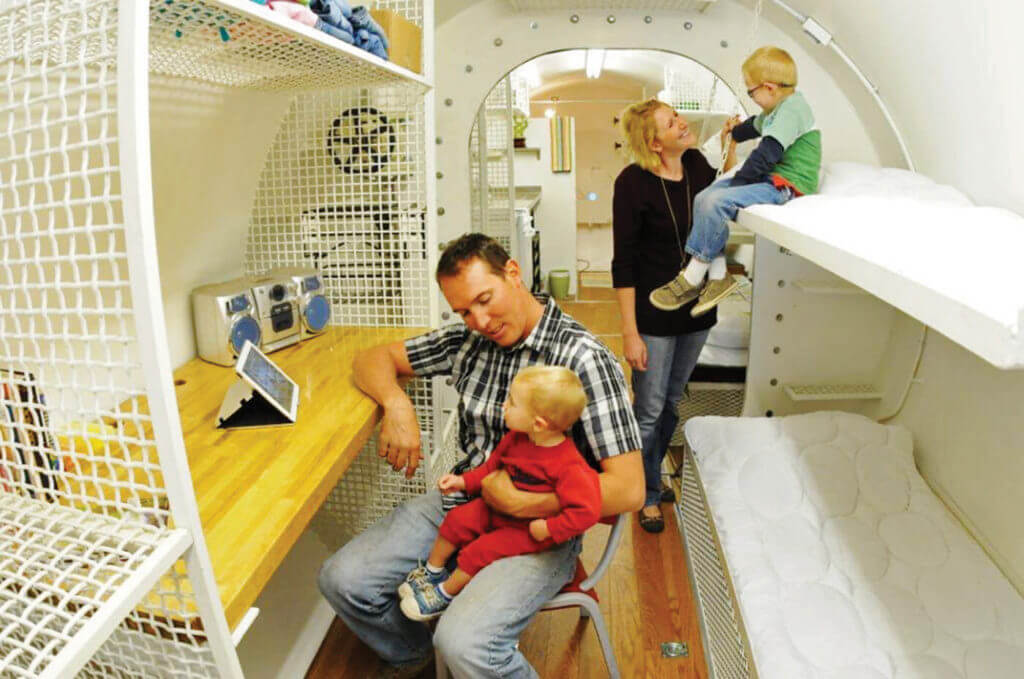PICTURE THIS. A tornado has encroached your neighborhood in the middle of the night. You dash to the front door but realize that it’s too late to run to your outdoor basement entryway because the tornado is heading straight for you. You know that you and your family are trapped—unless you have a hidden escape route.
Sounds like something that’s only available to Batman? Not anymore.
You can set up an emergency escape tunnel system or install a completely secure shelter where you can stay until help arrives, thanks to Security Disaster Shelters, which makes custom products to keep you and your family safe.
WHAT IT IS, HOW IT WORKS
 The company makes an emergency escape tunnel that suits your property. The tunnel can lead you outside to a pre-established safe house or to one of the company’s shelters.
The company makes an emergency escape tunnel that suits your property. The tunnel can lead you outside to a pre-established safe house or to one of the company’s shelters.
You can choose from either a re-deployable shelter, which can be mobile, or a permanent underground shelter that can be customized.
Security Disaster Shelters provides a secure place during the following:
• Hurricanes
• Tornadoes
• Forest fires
• Invasion
• Civil unrest
• Nuclear meltdown
INSIDE A SHELTER
The company can make an emergency escape tunnel that suits your property and remains unobtrusive. Constructed of a 3-foot by 7-foot tunnel of carbon steel, the tunnel has a grated floor, allowing you to safely walk through it. Security Disaster Shelters can create an access way to the tunnel from within your home so you can easily slip into it and get outside undetected.
The tunnel can lead you directly outside, to a pre-established safe house or to one of the company’s shelters. You can choose from either a re-deployable shelter, which can be mobile, or a permanent underground shelter that can be customized with multiple units to accommodate your entire family.
 The survival shelters won’t simply keep you from harm from the outside world—they’re actually as comfortable as a second home, with options like a working kitchen, bunk beds, a full bathroom, a stove and a shower. “We’ve had a few clients who have actually lived in their survival shelter while their house was being built,” says Riley Cook, owner of Security Disaster Shelters.
The survival shelters won’t simply keep you from harm from the outside world—they’re actually as comfortable as a second home, with options like a working kitchen, bunk beds, a full bathroom, a stove and a shower. “We’ve had a few clients who have actually lived in their survival shelter while their house was being built,” says Riley Cook, owner of Security Disaster Shelters.
Not only do the Survival Shelters keep you safe from natural disaster like tornadoes and hurricanes, but they can also guard you against invaders. You can install an optional camera to allow you to see what’s happening outside of your shelter. If you see someone trying to break in, you can even deploy a blowtorch to injure the approaching invader.
THE FIRST STEP
Before the company will commit to installing a Survival Tunnel or Shelter on your property, a representative will visit your site to confirm that your yard is amenable to the installation. “On the bigger projects, we go out and do a site survey,” says Cook. “We do soil sampling about 20 feet down and walk through it with the homeowner. Our shelters can be installed anywhere in the United States, and if it’s an underground shelter or tunnel, we can cover it and replant grass over the construction area so no one will even know it’s there.”
The company will then discuss your specific needs with you so the product can be customized to your preferences. “If someone needs wheelchair accessibility, we can make the entryway and the floor ready for that,” Cook says. “Or if they need extra freezer space or a separate refrigerator for medications, we can keep that in mind. If there are kids involved, we need to know up-front so we can make a comfortable space for them.”
ESCAPE TO SAFETY
Once your tunnel or shelter is complete, you can rest with a better peace of mind that no matter what problems heads toward your house, you can get out— without anyone knowing where you went.
PROTECTING YOUR FOOD STOCKPILE AND VALUABLES
Security Disaster Shelters not only makes escape tunnels and shelters—the company also constructs water- and airtight caches that can hold your valuables. The caches are built to your specifications and can be fastened to the exterior of your home or buried underground, while keeping your most important items safe and protected.
 You might also consider one of the company’s subterranean protected storage vaults, in which you can store food or other supplies in the 382 cubic feet of storage. A hatch and ladder allow you access to the underground storage area, but criminals would never know it’s there.
You might also consider one of the company’s subterranean protected storage vaults, in which you can store food or other supplies in the 382 cubic feet of storage. A hatch and ladder allow you access to the underground storage area, but criminals would never know it’s there.
WORRIED ABOUT EMP?
Depending on your geographic location, your first security concern may be an earthquake or tornado, but many homeowners are also concerned about the threat of electromagnetic pulse (EMP) disrupting their home’s security.
EMP is a burst of electromagnetic radiation, and it can result from a high-energy explosion, a solar flare, a nuclear bomb or other catastrophes. Security Disaster Shelters can provide you with EMP-shielded containers of various sizes to ensure that your valuables are secure from EMP concerns.
STEP BY STEP
1. A representative will visit your site to confirm that your yard is amenable to the installation.
2. On the bigger projects, the company does a site survey in which they do soil sampling.
3. The company discusses your specific needs so the product can be customized to your preferences.
4. If someone needs wheelchair accessibility, they can accommodate that.
5. If you need extra freezer space or a separate refrigerator for medications, they can do that.
6. If there are kids, they can design the shelter so it is comfortable space for them.
7. If it’s an underground shelter or tunnel, the company can cover it and replant grass over the construction area so no one will know it’s there.
The shelters can be installed anywhere in the United States.
$30,000 This is the price of the company’s most basic shelter or storage space.
$500,000 Designed with top-of-the-line appliances, air-filtration systems and communications stations, some units could go as high as $500,000.
DIG A LITTLE DEEPER
To read more about the company’s products, visit www.securitydisastershelters.com.
Editor’s note: A version of this article first appeared in the 2013 print issue of American Survival Guide.




